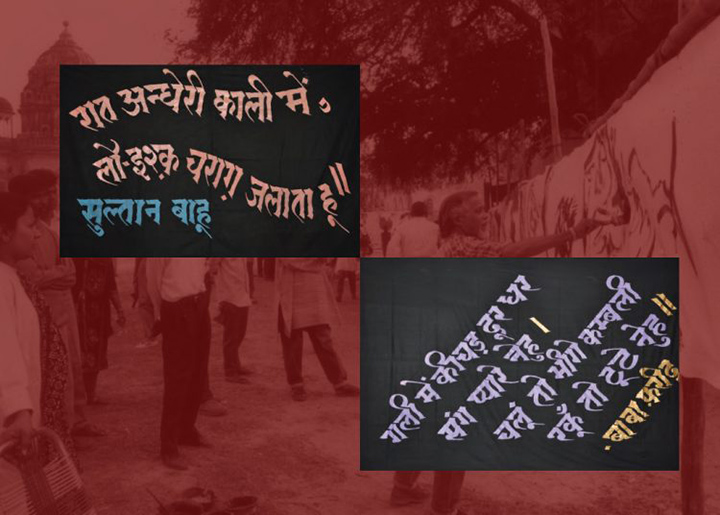Ashley Tellis reviews the Sahmat exhibition Hum Sab Sahmat, commemorating 75 years of Indian independence
The Sahmat exhibition ‘Hum Sab Sahmat,’ celebrating 75 years of India’s so-called Independence, and about to close at the hideously obscene Jawahar Bhavan (a colossal waste of public money) interpellates the viewer into the clarion call of its title (‘We are all in agreement’). But what if we are not? This reviewer certainly is not. How does one articulate disagreement even if one stands by at least some of the ideals behind the exhibition – secularism, democracy, non-violence?
Sahmat was formed after a brutal act of violence that killed one of the most talented theatre practitioners this region has ever seen: Safdar Hashmi. He was killed by Congress goons (led by Congress leader Mukesh Sharma). There is hardly a need to underline the irony, then, in the fact that this exhibition being held in a Congress structure. Be that as it may, Sahmat, then led by Hashmi’s sister, Shabnam Hashmi, has cleaved to the Congress version of secularism and democracy. Shabnam Hashmi later apparently left Sahmat and started Anhad but the difference between them remains tenuous. Aban Raza of Anhad curated this exhibition. The websites of Sahmat and Anhad are interchangeable. See About SAHMAT and Anhad | About Us (anhadindia.com). This is the first point of disagreement for this reviewer. The Congress version of these things has always been, to his mind, a soft form of Hindu majoritarianism.
The second difference, and even larger, is the unstated (and overstated) investment in nationalism. Gulam Mohammed Shaikh’s (one of the finest painters in the region) exhibit is the weakest. Tagore did not believe in nationalism. Putting him opposite Gandhi in the frame is a mistake and an insult. Perhaps he should have read the correspondence between the two men more closely. But Sahmat, as a whole, has not read Tagore. Tagore despised nationalism and urged us to be critical of it. Sahmat is not. It celebrates it. The subtitle of the exhibition is ‘Resisting a Nation Without Citizens’.
The third is Sahmat’s behalfism. It speaks on behalf of an unspecified Us All, collects marginalities like seashells and puts them on display. It does not understand that many of these are not citizens in any sense of the word. The Muslim has never really been a proper Indian citizen. So Vineet Gupta’s words, under his photographs of the lynched 15 year old Junaid Khan from Haryana, on his behalf, spoken to his mother, Saira Khan are deeply offensive. He speaks to them from heaven where, he says, there are no marauding mobs. Apart from the erasure of Saira, his mother’s pain and suffering (Saira is angry and has been fighting for justice for her son in this world, not in heaven ‘He Would’ve Been Alive If He Wasn’t Muslim’: Junaid’s Mother, 5 Years After His Lynching (thequint.com), this exhibit does not even let Junaid speak in his own voice. We do not have his voice. Perhaps his photograph would have been better.
Ram Rahman, in a newsclick video on the exhibition, claims to be very moved by that exhibit. Given the utter mediocrity of his exhibit (and his work in general), that would be the case. He evokes Nehru uncritically, his mother, Sonia Gandhi and Souza (poor Souza, clubbed with these fools) against a completely irrelevant and pointless photograph in Hyderabad.
The fourth difference is in Sahmat’s impoverished nature of the artistic languages of these exhibits. The national flag being simultaneously cut open and sown (Tanmay Aggarwal), Kali with her tongue out (Nehal Devi), Shaheen Bagh (Tejaswita), Aruna Roy’s awful attempts at art (as if her attempts at activism are not arid enough), Paul Zacharia discovering obviousness and banality, not entirely unlike in his fiction.
Rahman, in the video, says none of the exhibits have been edited. Fair enough. However, Aman Raza curated them. Couldn’t he have used some discretion and leave the banality out? This exhibition is similar to the Words and Images one that Sahmat had in 1991-92. Painters, writers and photographers were sent a 12×12 blank canvas and asked to put their thoughts (which are articulated in humans in words) into images (and sometimes words). Images are also words or interpreted in words both in the mind and in written analyses of them so the conjunction ‘and’ between them is a false one. Words are images; images are words.
The fifth is the naïve faith in words, as though words need no work. Words in the exhibition did not made much sense either, like father and daughter, T. P. Sabitha and K. Satchidanandan’s statement, banal and prosaic poems, rehearsing the obvious through plangent platitudes.
One might go on but what would be the point? Over 300 artists have offered us the weakest defence against the majoritarian onslaught upon us. This artistic work is just not going to cut it. We need creative languages to counter fascism, not name-calling and the reiteration of retrograde cliché. The languages of Congress commensality and Sahmat secularism are well and truly over and good riddance to them.
We need to re-define them. But for that we have to jettison the tired artistic languages of these ideologies and re-imagine what it is to be secular and what it is to counter fascism.
Ashley Tellis is an academic, journalist, editor and LGBH activist based out of Delhi.
Photo courtesy : InderSalim and various sources online.



